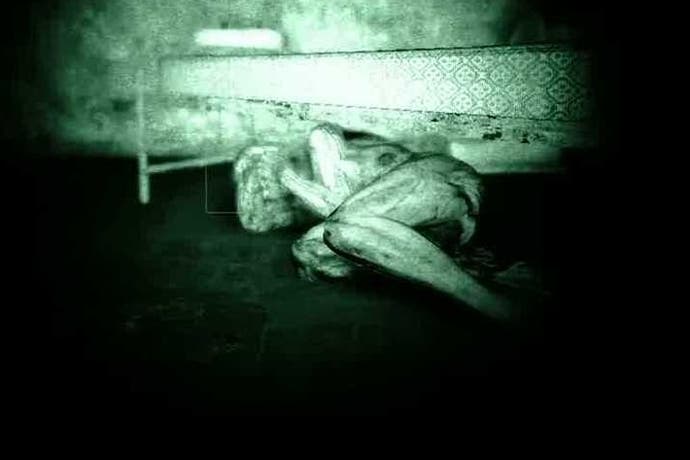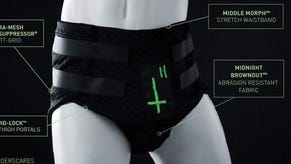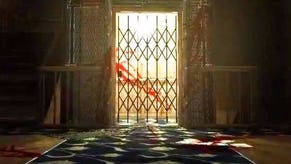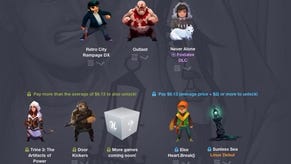Outlast review
Asylum's eeker.
First-person horror Outlast uses careful audio cues to announce when the angry, mutilated denizens of the asylum you're investigating spot you pootling around in their vicinity - but it took me about two hours to realise that. That's because, 15 minutes into the game, I'd alt-tabbed three times to calm down before deciding the best course of action was to set up a Spotify playlist of the most cheerful music I could think of and run it at half volume as I played. Let me tell you that being grabbed by a seven foot mass of horror-muscle intent on pulling your head from your neck is scientifically less scary when set against the Vengaboys' seminal 'Boom, Boom, Boom, Boom!!'
It's still scary, though. As journalist Miles Upshur, I was poking around in an asylum after an anonymous tip told me bad things were happening to its patients. Upshur is seemingly the most committed journalist in the world: 30 seconds after breaking in, he's confronted with a load of entrails and dead security guards, yet he presses on. I sometimes put "journalist" in my email signature, and I would've gone home at that point.
But he doesn't, because he's convinced he's going to document the asylum's secrets on video camera. That camera is Outlast's only tool, and it has to be kept topped up with batteries. Luckily, Upshur seems to have stumbled across the world's only battery-powered asylum. They're everywhere: on counter tops, under desks, bafflingly in sinks. Only once during Outlast's campaign did I come close to emptying my last battery, and that was because I spent 20 minutes stuck on a puzzle.
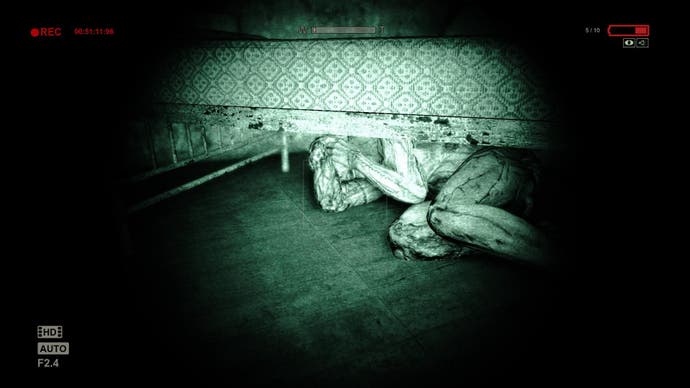
In addition to being hyper-dedicated to his job, Upshur is also an apparent pacifist - no weapons cross his palms across the game's five-hour story. It's lucky he's brought the camera, as most of the aslyum is inky dark. The camcorder's night vision mode is the only way to pick a route through the place. Anyone who's seen the superb Spanish horror film [REC] will know where this is going. The night-vision mode is vital to progression, but it's also a way to render the asylum's terrors - patients, ruined and mistreated by someone or something in charge of the place - doubly scary. They loom out of the barely illuminated darkness, bodies and eyes picked out in an otherworldly green.
Not all of the asylum's inmates want you dead, but a good proportion do. Chief bastard amongst these is a seven foot tall Hunk-a-like, so muscular that his head and neck form a meaty triangle. He appears at regular intervals, pounding down doors and stalking down hallways. When he did pick me up, he displayed a particular love for chucking me back to the floor again. Sometimes he'd chuck me out into hallways, leaving me enough time to sprint to freedom, or at least to one of countless conveniently placed lockers I could hide inside. Other times, he'd hurl me at dead ends, giving him enough time to pick me up and chuck me again before picking me up for the final time and twisting my head from my spine like the cap off a bottle.
Outlast's other patients are similarly slow to finish the player off, taking three or four swipes before Upshur's vision swims, he stumbles, and he's sent back to one of the game's generously spaced checkpoints. The two reactions to being spotted in this game are a) run, and b) hide: for the first half of the game, I used tactic b), ducking under beds and behind desks, listening to Upshur's heavy breathing (and, very quietly, Wilson Phillips) as my foe plodded around the room trying to find me. The first 10 times I hid in a locker and prayed the door wouldn't be swung open, I was terrified. After that, I was something worse: a bit bored. There's a lot of waiting around in the dark, and too much of it is spent waiting for monsters to go back to their assigned positions.
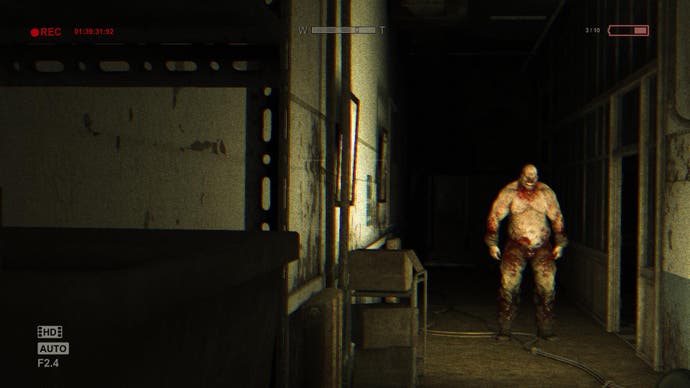
Three hours in and I'd realised that more often than not, a) was a better tactic. When murderous asylum residents appeared in the gloom, I started to run toward them, brushing past their mouldy shoulders on my way to the door they'd inevitably just kicked down. Hiding still had its uses, but patrol routes were too difficult to divine with a corner-peeping lean function alone - and the enemies too random in the distance they'd spot me from - to make tactical cowering a real possibility. With a way to lure or distract enemies, I could have made better use of my surroundings, but I saw a good portion of the asylum at sprint pace, through flailing arms and with pounding heart.
Most of Outlast's frights are effective because they're brute force... but it also plays with revulsion and personal space for some subtler scares
Scares are subjective - as a barometer for my level of bravery, I once creeped myself out so effectively reading about Silent Hill on GameFAQs that I had to move my PC to face the door - but most of Outlast's frights are effective because they're brute force. There's little nuance in hiding a facially scarred bogeyman behind a door and having him jump out while violins play the violin version of "boo!", but as a shock tactic, it works. I only stopped displaying physical reactions to these surprises after consecutive hours with the game, after my nerves were too tattered to care that Jason Vorhees' little brother had just appeared from behind a door to gurn into my camera.
But Outlast also plays with revulsion and personal space to make for some subtler scares. Some inmates display non-aggressive but weird reactions to your presence, and these are some of Outlast's most powerful and lingering weapons. I spotted a pianist through a window and watched him play. After a few seconds, he stood up and turned around. His face was a mess of skin grafts and scars, burns obscuring his eyes. He walked toward the window I'd spotted him through, and tilted his head back in an approximation of a 1997 nu-metal band press shot. I recoiled, both in the game and from my keyboard.

Eventually, familiarity starts to breed comfort with the asylum's residents. One of the first things you'll do is walk through a room as three mangled but very much alive people watch a static-blaring TV. It took me 15 minutes, three alt-tabs, and a walk around my house before I could make it through and back out of the room. By the end of the game, I was dandering past prostrate and praying patients in an attempt to uncover the the asylum's story.
That story is told through diaries and Upshur's own notes, jotted down when you've recorded a plot point unfurling. It's a slightly muddled tale, interspersing technology with the supernatural to weave a yarn that dips in and out of horror cliché. More aggravating is the insufficient signposting the diary method allows: at one point, I wasted three batteries before I realised a broken staircase I'd assumed impassable had to be jumped. At another, I spent far too long fumbling around in the dark, trying to work out where a key in a chute had dropped to. The answer involved significant backtracking, something Outlast doesn't often ask the player to do.
When it does, it'll want you to collect a few of something, or turn a few of another thing. Whoever built this battery-powered asylum had a serious love for valves: Upshur has to turn loads of them to progress. An early trip to the sewers forced me to contend with a roving monster as I crept from a hub room, down two diverging corridors to remove the water from a pipe. That puzzle template is repeated over and over, occasionally replacing valves with switches or fuses.
Despite these hubs - and some clever level design that gives the illusion of space - progress in Outlast is linear. There's little chance to branch off the main path and explore - but that's for the best. Stop and peer too long into Outlast's gloom and you'll see the zips on the monster costumes. Take it at at speed and you'll find a haunted house worth visiting.
